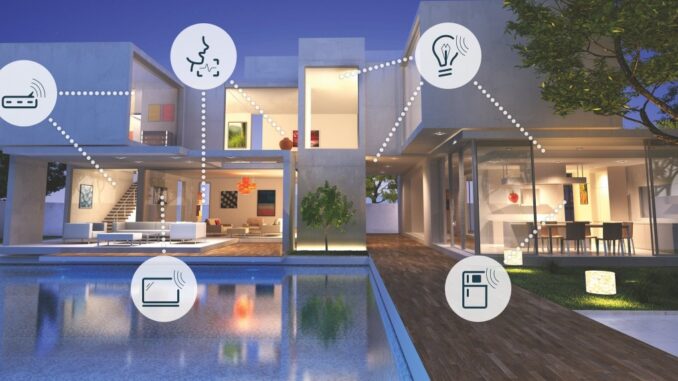
In recent years, the concept of smart homes has transformed the way we live and interact with our living spaces. Smart home technologies leverage the power of the internet and advanced devices to create a connected living experience, enhancing convenience, comfort, and energy efficiency. Technology has radically changed the way we communicate, operate, and even live in recent years. It has impacted every area of our life. With the emergence of smart houses, real estate is one key area where technology has advanced significantly. The way we interact with our living environments is being revolutionized by smart homes, which provide convenience, efficiency, and increased security. In this article, we’ll study the idea of smart houses, go through their features and advantages, talk about how they affect energy efficiency and environmental sustainability, look at smart security systems, and lastly consider what the future of smart homes holds. From controlling household appliances with a simple voice command to monitoring home security remotely, the possibilities of smart homes are continually expanding.
Homes that have linked, remote-controllable gadgets and systems are referred to as smart homes, automated homes, or intelligent houses. Homeowners may manage and monitor many parts of their houses from a centralized control panel or even through their smartphones thanks to these gadgets’ usual Internet of Things (IoT) connections.
The convenience that smart homes provide is one of its main benefits. Homeowners may remotely manage several components of their houses thanks to automated technologies. For instance, they can change the thermostat while they’re still at work to guarantee a pleasant environment when they get there. With the ease of their smartphone, they can easily switch on the lights, prepare the oven, or even start the washing machine.
Let’s explore some of the latest technologies that are driving the evolution of smart homes and revolutionizing our daily lives.
Table of Contents
Voice-Activated Assistants
Voice-activated assistants, such as Amazon Echo with Alexa, Google Home with Google Assistant, and Apple HomePod with Siri, have become the centerpieces of many smart homes. These AI-powered devices respond to voice commands, allowing homeowners to control various smart devices, set reminders, play music, access information, and even place online orders hands-free.
Smart Lighting
Smart lighting systems offer customizable and energy-efficient solutions for illuminating your home. With smart bulbs and lighting systems, you can adjust brightness, color, and ambiance using a smartphone app or voice command. Additionally, some systems can be programmed to simulate occupancy, enhancing home security while you’re away.
Home Security and Surveillance
Smart home security systems provide advanced monitoring and protection for your property. Features include smart doorbell cameras, indoor/outdoor security cameras, motion sensors, and smart locks. Users can receive real-time alerts and remotely monitor their home security from their smartphones.
Smart Thermostats
Smart thermostats offer precise control over your home’s heating and cooling systems, leading to energy savings and enhanced comfort. These devices learn your heating and cooling preferences, adjust temperatures based on your schedule, and can be controlled remotely via smartphone apps.
Home Automation Hubs
Home automation hubs serve as the central command center for smart homes, allowing seamless integration and communication among various smart devices. They enable users to create automation routines and scenes, enabling multiple devices to work together based on preset conditions.
Smart Appliances
Smart appliances, such as refrigerators, ovens, washing machines, and dishwashers, offer innovative features that enhance efficiency and convenience. For example, some smart refrigerators can create shopping lists, track food expiration dates, and even suggest recipes based on the available ingredients.
Smart Entertainment Systems
Smart entertainment systems bring the cinema experience to your home. Smart TVs can connect to streaming services, gaming consoles, and other devices. Home theaters equipped with smart sound systems can be controlled remotely, offering immersive audio experiences.
Energy Monitoring and Management
Smart energy monitoring systems help homeowners track and optimize their energy usage. These devices provide real-time insights into electricity consumption, allowing users to identify areas where energy efficiency can be improved.
Smart Water Management
Smart water management technologies, such as smart irrigation systems and leak detection devices, help conserve water and prevent water wastage. These devices can be programmed to water plants at optimal times and send alerts in case of leaks or water-related issues.
Connected Health and Wellness Devices
Smart home technologies also extend to health and wellness. Smart scales, fitness trackers, and health monitoring devices can sync data with smartphones, providing users with valuable health insights and progress tracking.
As smart home technologies continue to evolve, the possibilities for connected living experiences are endless. The convenience, energy efficiency, and enhanced security offered by smart homes are driving their increasing adoption among homeowners worldwide. As more devices become interconnected and AI capabilities continue to advance, smart homes will likely become an integral part of our future living spaces, providing personalized, seamless, and innovative solutions for modern living.

Leave a Reply